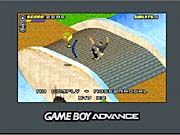One of the biggest surprises of the Game Boy Advance launch lineup was Tony Hawk's Pro Skater 2, which featured simple polygonal riders in an isometric environment and proved to be surprisingly playable. Though, perhaps even more surprising has been the proliferation of action sports titles on the GBA. Almost all the big console action sports series--Tony Hawk, Mat Hoffman, Dave Mirra, Aggressive Inline--have been given a similar treatment, and to good effect. Now, Vicarious Visions brings Tony Hawk's Pro Skater 4 to the GBA. It doesn't quite make Tony Hawk 3 obsolete, but rather gives the handheld crowd yet another excellent action sports game to choose from.

The handheld series' controls haven't changed dramatically since Tony Hawk 2 first hit the GBA. In Tony Hawk 4, lip tricks, grab tricks, grinds, and ollies are performed using the L, R, B, and A buttons, respectively. Reverts and manuals still work as they did in Tony Hawk 3, making it easier to chain together long strings of tricks for bigger combo points. Like in its full-sized console siblings, the big gameplay addition in Tony Hawk 4 for the GBA is the spine transfer. If you're skating a half-pipe that is back-to-back with another half-pipe, you can seamlessly transfer from one to the other by pressing both shoulder buttons while you're in the air. You can also use the spine transfer to save yourself from a bail if you misalign a vert trick and are in danger of hitting the pavement instead of the ramp. The spine transfer isn't as radical a gameplay enhancement as the revert and manual were when they were first introduced, but every level is designed to take advantage of it in some way, and it certainly takes some of the edge off the game's isometric perspective. Tony Hawk 4 also introduces flatland tricks to the Game Boy Advance, which can be executed by performing a manual while your special meter is full and then pressing different buttons in tandem with directions on the D pad.
Aside from the addition of the spine transfer, the other big change found in Tony Hawk's Pro Skater 4 is the layout of the career mode. The pervasive two-minute time limit has been done away with, and you now have an infinite amount of time to skate around and explore the levels. You activate objectives by approaching certain pedestrians on the street and tapping the L button, at which point they'll present you with a challenge and the clock will start ticking. As in past Tony Hawk games, the challenges include the standards, like collecting letters to spell "skate," finding hidden tapes, and completing point-based challenges. There are also plenty of level-specific challenges, such as finding five frat boys in the college level or causing the elephant at the zoo to stampede. The sheer number of goals included here simply dwarfs what we saw in Tony Hawk 3, and since you don't have to complete the same goals over and over again with each different skater, the game stays fun for longer. The multiplayer modes found in Tony Hawk 3 return in Tony Hawk 4, including trick attack, HORSE, tag, and king of the hill, though this time the game has multiplayer support for up to four players.

Every Tony Hawk game on the GBA has looked good, and Tony Hawk 4 is no exception. The skaters, which are rendered with simple but effective polygonal models, don't really look any better than they did in Tony Hawk 3, but they still look good. The trick animations, however, look downright spectacular. Almost every trick is identifiable on sight, and they all have a smooth, natural look to them, especially some of the flatland tricks. Though the skaters look and animate well, the pedestrians you'll encounter look much blockier and have maybe two or three frames of animation. They look especially jerky when placed next to the rather refined skater models. The levels, which are essentially the same levels found in the console versions of Tony Hawk 4 on a smaller scale, serve as a fine backdrop for your endeavors, and each one represents its respective environment well. The sound design in the Tony Hawk games has always been second to none, combining highly realistic skate sounds with an awesome licensed soundtrack. Much of the sound samples have made their way to Tony Hawk 4 on the GBA, though at a noticeably lower bit rate. Unfortunately, the licensed soundtrack got the axe. The synthesized music that's there in its place isn't quite as good or as varied, but it still capably evokes the general feel of the hip-hop, heavy metal, and punk rock genres.
The biggest shortcoming of Tony Hawk's Pro Skater 4 for the Game Boy Advance is its failure to capture the full scope of its console counterparts, though the GBA hardware itself is arguably more to blame for this than the game itself. It may be a comparatively modest effort, but Tony Hawk's Pro Skater 4 for the GBA is a fantastic entry in the series and one of the best action sports games for Nintendo's handheld.